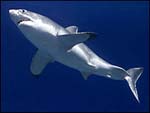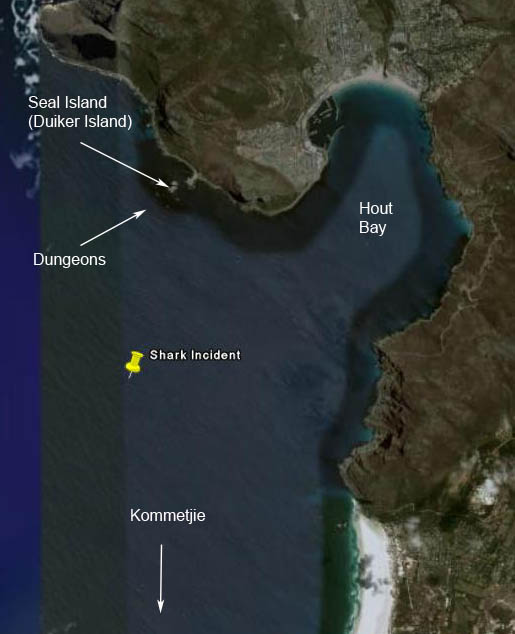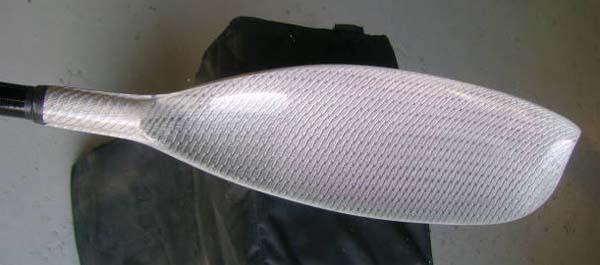Shark Incident near Hout Bay
 Sharks are
a highly emotive topic, especially when combined with surfing or paddling, but here in Cape
Town we have to face the fact that we share the water
with them when we paddle.
Sharks are
a highly emotive topic, especially when combined with surfing or paddling, but here in Cape
Town we have to face the fact that we share the water
with them when we paddle.
This incident is published to illustrate that an encounter even with an aggressive Great White need not end badly. We also asked shark researcher Allison Kock what paddlers should do when faced with such a situation.
Joe Kearney's Story

On Saturday morning, 12 May 2007, I set off with legendary Peninsula paddlers Ian Trautmann and Rory Cole on a longish paddle from Hout Bay to Kommetjie as part of our World cup training.
It was a peach of day, absolutely no wind, beautiful blue skies mirrored by an inviting glassy blue ocean.
Dolphins
We paddled towards the Dungeons surf break stopping to admire the huge sets rolling in and then headed south towards Kommetjie. The conditions were glassy with at least 10-12 foot swells. About 2km out to sea from Dungeons I suddenly noticed that we where not alone and shouted to the guys I had seen something beneath my boat. My terror turned to instant relief as I saw a friendly dolphin fin broach the water a couple of metres ahead of us and then a few more around us. We admired the dolphins which were the dusky type, quite common to our Cape waters.

Rory suddenly exclaimed that the dolphin swimming just to his right below him was definitely not a dolphin - in language I would hate to repeat [Editor: Rory denies any use of bad language!], and that in fact he was certain it was a Great White. We asked him if he was 100% certain and he said he could see the whole shape and it was definitely a great white at least 3 m in length. We continued paddling closely together as a pack, cautiously, hoping it would lose interest. I must add luckily for me I happened to land up in between Rory and Ian which certainly gave me an increased sense of security!
Mock(?) Charge
The next minute there was a commotion in the water and all I saw was a tail fin do an about flick at high speed, milliseconds before it would have come crashing side on in Rory's ski. Rory said it happened extremely quickly, but he had seen the pectoral fin coming straight at him and that the shark had turned from its attack at the last minute. Fortunately for us that was the last we saw of the shark and we continued our paddle to Kommetjie and back although I must add every time a seal breached the water there was a slight air of uneasiness amongst us.
Silver Blades
Our theory is that we must have paddled right over a school of dolphins feeding on yellow tail or some other shoal of fish and the great white was trying to scare us off. Rory was paddling with silver blades, and another plausible theory is that the Great White mistook the shimmering of the blades for a small gamefish. Either way our advice to sea paddlers is rather don't paddle with silver blades, as this Great White's line of attack appeared to be directed straight at Rory's blade in the water. You can be assured that Rory will not be paddling on the sea with those same blades again!
New Scientist Magazine: "The Handy Guide to Shark Body Language"
In the 28 April 2007 edition of New Scientist Magazine, there's an article about a research project that has catalogued threat displays in 23 species of shark.
Two such threat displays, associated with Great Whites, are swimming slowly and rolling over onto one side, and mock charges.
Clearly this shark was not pleased with the surf skis. So much for recognising the threat display - but what do you do about it?
I forwarded Joe's email to Great White Shark researcher Alison Kock and asked her for her comments.
Alison Kock - Great White Shark Researcher
The shark spotters have had a few sightings in the Noordhoek / Kommetjie area this month and last (i.e. April/May 2007) for the first time since they initiated the programme there last year. If you want more information on this you can contact Andre from the shark spotters at 0846590453.
Marine & Coastal Management attempted to tag sharks in the area two weeks ago as we have two receivers in the area, but had no success, they never even saw one. Our knowledge of white shark occurrence in this area is poor.
Change-over Time
However, this time of year is what we call 'the change-over time' where major changes occur in shark habitat use from summer to winter areas.
Many people are under the belief that if you see dolphins then there are no sharks, when in fact there is evidence that white sharks attack and eat dolphins. It's been recorded that large sharks follow whales, opportunistically feeding on dead or vulnerable calves & the same may be possible for dolphins.
If you see a shark - stop paddling
With regards the silver blades, it is very possible that the silver colour may attract a shark's attention. The movement may also be the attraction. I would advise that if you encounter a white shark for you to stop paddling as it's very possible that the movement of the kayak may act as a trigger.

To give you an example: many tour operators use seal decoys towed behind the boat to illicit breaches/attacks. The sharks launch full out vertical attacks on these moving decoys. However, when the decoy is stationary it does not illicit the same behaviour from the shark. The shark may approach the stationary decoy, but not launch a full out attack. Interestingly, a scientist decided to test shape discrimination abilities and towed a square cut-out behind the boat and it was hit almost just as often as the seal shape while it was being towed, so it pointed to the fact that it was actually the movement of the decoy and not the shape that mattered so much.
Recommendations
It seems then, that silver blades may not be a good idea. We recommend painting them a different colour (mine are neon pink for safety/visibility reasons and I'm just hoping that sharks aren't attracted to neon pink!)
And, if you do spot a shark, it may be best to stop paddling and just sit still on the water for a few minutes.
I recently replaced the rudder on my ski - the new one is silver-ish and I asked Alison what colour I should paint it. "Of course there is no scientific proof on this," she replied, "but my personal choice, based on observation with the sharks, would be to choose a dull green."
Paddling - an extremely safe sport
Either way, the chances of encountering a shark are extremely small, and the chances of being injured in an incident are infinitesimal. We know of only one person on a surf ski being injured, ever, and that was many years ago off Durban when a paddler stuck his feet over the side while he was waiting for a buddy to come out through the surf. A small shark bit one of his feet, causing lacerations...
You're far more likely to be injured while driving to the beach - take care!

